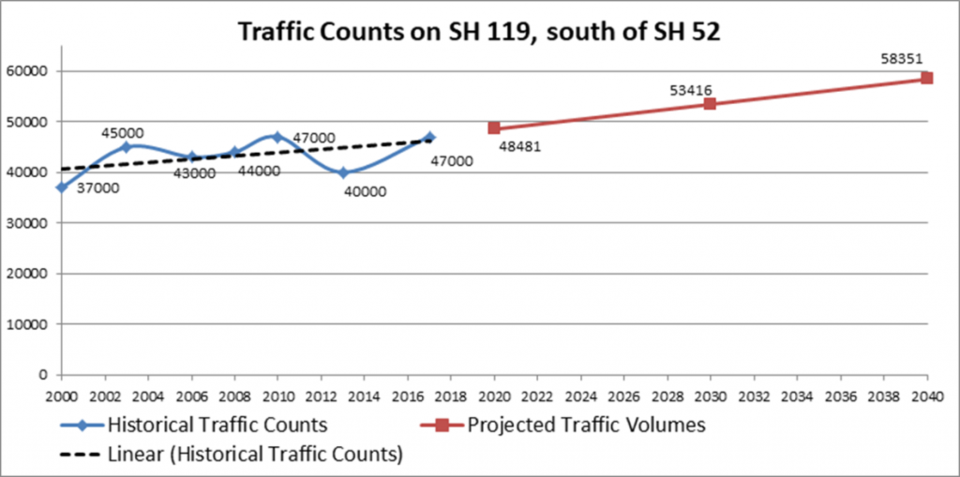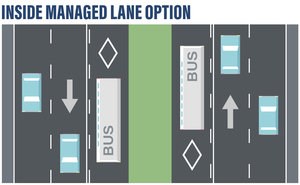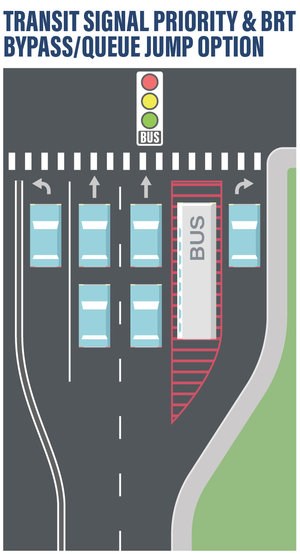This content was originally published by the Longmont Observer and is licensed under a Creative Commons license.
The latest in a series of public meetings about the RTD Bus Rapid Transit (BRT) program affecting SH119 between Longmont and Boulder was held at the Niwot Grange on the 6th December. About 50 people were in attendance for the presentation led by Scott McCarey of the Boulder County Transportation Department.
Technical difficulties meant the visual aids had to be presented manually, but the maps and charts clearly showed the complexity and detail of the various options currently being considered by the stakeholders with public input.
Traffic on SH119 has been increasing steadily over the last twenty years and is projected to continue at the current rate according to CDOT:

The introduction of Light Rail along the 119 corridor is now postponed by RTD until at least 2040, so improving or replacing the existing BOLT and J bus services is a priority for increasing public transportation ridership – getting people out of their cars.
The current bus schedules between Longmont and Boulder involve a total estimated journey time of 66 minutes, with 55 to 60 stops along the way. One option being considered is to keep the existing J and BOLT routes, but increase the frequency outside of rush hour (every 15 minutes) to 30 minutes all day instead of 30 to 60 minutes. It is estimated that this would increase daily bus ridership from 1,480 to 2,160.
There are three additional options that come under the BRT umbrella, which would decrease the number of stops along more or less the same routes but complete the full Longmont/Boulder journey in about 40 minutes – a time saving of over 20 minutes. The current limited services covered by the J route on 17th Avenue, Hover and Nelson, as well as the CU East Campus destination, would be increased in frequency and offer all-day service. Detailed maps of the various options, including the number of stops can be found at the SH119 website at https://www.sh119brt.com/#why.
In addition to route and schedule adjustments, the BRT plan includes upgrading or changing the bus stations and the routing options on 119, similar to some of the options used for the Flatiron Flyer commuter bus to Denver. The first, and cheapest, alternative is the Bus-on-Shoulder option, which allows RTD bus drivers to travel on the hard shoulder if the main traffic flow is 35 mph or slower. The buses cannot travel faster than 35 mph on the shoulder. This could be put into use immediately.
The second option is the Inside Managed Lane alternative:

Similar to the HOV lanes on Highway 36, this would be a lane closest to the highway median, with traffic restricted to buses, High Occupancy (3+) Vehicles, or low occupancy vehicles willing to pay a toll. In the case of 119, this would mean widening the carriageway, with all the resulting road construction work, as well as building superior bus stops and stations.
These stations would have the BRT/bus arrival updates and ticket purchasing, as well as enhanced parking. This would be the core of the BRT alternatives that includes limited stops and a much faster journey time. It could involve partnering with a private company to run the toll service.
Another option being considered is snappily called the TransitSignal Priority and BRT Bypass Lane/Queue Jump.

This alternative would be constructed at major, congested intersections on 119, such as at SH52/IBM or 63rd Street. The intersections would be widened, adding a lane for bus access only, which will have a dedicated traffic signal to give the buses a head start before the rest of the intersection signals, allowing them to merge more smoothly into regular traffic lanes on the other side of the intersection.
In addition to these core variants of the SH119 BRT program, other options of particular interest to the Niwot attendees were discussed. Chief among these was moving the existing Longmont-bound station to 2nd Avenue.
While Scott McCarey believes that moving the new and improved BRT station from the main Niwot shopping street could increase bus ridership, it was agreed that there could be issues with increased parking requirements, despite making it easier for Niwot residents and visitors to use public transportation.
The evening ended with the usual lively Q&A session, but there seemed to be general agreement that the BRT options presented were worth pursuing in more detail. As always, public input is vital to the success of such projects, and this can be done via the website referenced above or at any of the future public meetings in February, 2019 in Longmont and Boulder.
The project timeline predicts a decision to be made by RTD in mid-2019, funding options pursued in 2020, final design work in 2021 and 2022, and then construction to begin in 2023.

.jpg;w=120;h=80;mode=crop)
